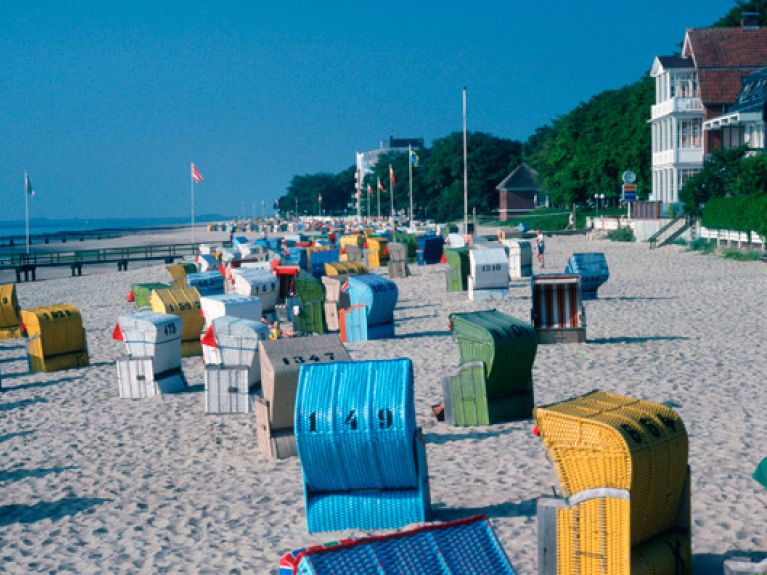Islands of opportunity
Each of the German North Sea and Baltic islands is unique – and a small world of its own.

“The weather!” exclaim some, and immediately categorize a holiday on a Baltic or North Sea island as “adventure travel” – because of the risk of sitting in the rain for a day or two. “But what about the endless beaches? The fresh air! The light! The wide-open spaces! And the way the sea and the sky touch at the horizon!” enthuse others and claim they would never exchange their island break on the North or Baltic Sea for a Caribbean trip. And they are in the majority: these islands within their own country are at the top of Germans’ list of dream destinations. This suggests an appealing form of indefatigability, and you will definitely need some of that in your luggage for a trip to the islands – as well as rubber boots, books for rainy days and factor-25 sunscreen – just to be prepared for all eventualities. But you will also be richly rewarded.
After all, the islands are living proof that true beauty does not only come from within, but always from outside, too: from dramatic cloud formations, or from a raging sea that can suddenly become as tame as a lapdog. There is hardly anything as incredibly quiet as Sylt’s Wadden Sea, or as romantic as Rügen’s tree-lined avenues and Usedom’s spruce forests. There are superlatives wherever you look: endless beaches, noble seaside-resort architecture, the earthiness of low, thatched cottages and the hard-edged character of the islanders. Not to mention the incredibly clean air, which is so healthy – not only for your respiratory system, but apparently somehow also for your soul. It’s pure joy – and there’s so much of it!
Germany has more than 70 of these islands. The most beautifully named is probably a tiny island called Liebes (“Darling” or “Dear One”). It’s in the Baltic between the islands of Rügen and Ummanz, uninhabited, 1,000 metres long, a maximum of 200 metres wide, and only 1.5 metres high. Not exactly perfect dimensions for an island. Especially since the competition is so big – literally. At the top of the list is the Baltic island of Rügen, which weighs in at 926 square kilometres and 1.3 million visitors a year. It’s followed by Usedom, Fehmarn and Sylt. With its illustrious list of celebrity visitors – starlets, stars and VIPs from the spheres of culture and politics – and its high property prices, Sylt is known as the “it girl” among the German islands. By contrast, the North Sea island of Juist with the “most beautiful sandbank in the world”, is not the best place for posing, because – being almost car-free – you can’t nonchalantly roll up in your Porsche. It’s so decelerated here that even the horses are restricted to walking pace.
Hiddensee – the only true island in the Baltic because it really is only accessible by boat – is also car-free. In the 1920s, great minds like Albert Einstein and Gerhart Hauptmann used to come here to get over their mainland stress. A motivation which – alongside the excellent connections between the mainland and the island – brings hundreds of thousands onto the islands. Today, fishing is no longer the main source of income, but tourism. And the islands are increasing espousing an environmental awareness in their endeavours to help visitors find their way back to the essential things of life – and, of course, find their way back to the islands.
For the most part, the flora and fauna are looked after in an exemplary manner. Take the Baltic island of Vilm. In the old GDR days it was reserved as an exclusive vacation destination for government ministers. Today, Vilm is a biosphere reserve offering unique plants and animals – and only 30 people are allowed to visit per day. Popular lore therefore seems to have it right: “In a sea of difficulties there is always an island of possibilities” – somewhere out there, off Germany’s Baltic and North Sea coasts. Life there still seems to be part utopia: suggesting that life itself could be like that – detached from the stress of the mainland, infinitely open, yet clearly encircled by the sea, so that we immediately feel at home and in good hands. No wonder people’s love for an island often lasts a lifetime – from the first sand castle until the last spa concert at Westerland’s big shell-shaped bandstand. Through pleasant, sunny times and rainy days alike. ▪
Constanze Kleis